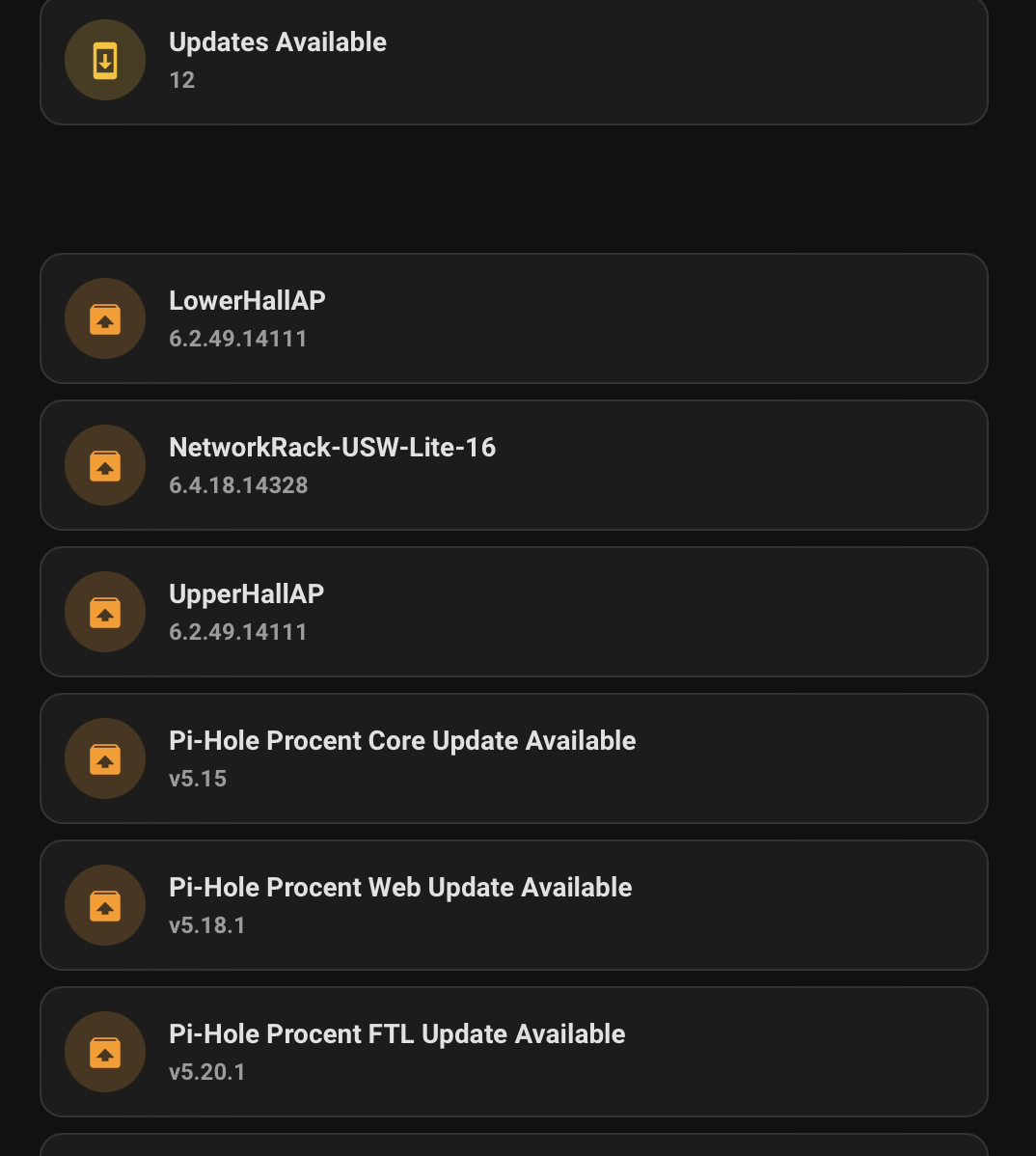Counting Sensors in Home Assistant
I have been building up my Home Assistant dashboard for a while, mostly using Mushroom Cards. My main dashboard started off largely inspired by this Everything Smart Home tutorial and has continued to evolve as I have thought of new ways to make it more useful.
At the very top of my dashboard I have a few informational chips:

From left to right is the built-in weather chip, followed by a count of the lights currently on and then a count of devices that have updates available to them.
These latter two chips use custom sensors created using the template integration and took a bit of fiddling to get working right, so I thought it was at least worth sharing my configuration. Yours will likely be a bit different depending on exactly what combination of devices & integrations you use. This integration is not currently configurable through the user interface so requires updates to the Home Assistant configuration.yaml file (or whereever you have your cusom sensors defined).
Lights
My sensor configuration is:
template:
- sensor:
- name: 'Lights On'
state: "{{ states.light | rejectattr('entity_id', 'in', ['light.main_bedroom', 'light.child_bedroom_group', 'light.living_room', 'light.hall']) | selectattr('state', 'eq', 'on') | list | count }}"
Creating these sensors was the first time I had really worked with Jinja2 templating, but if you have used any kind of templating configuration language before the conceps are pretty similar.
Breaking this one down our state definition has 5 main parts, separated with pipe (|) characters:
states.light- start with all the state information for thelighttype of entitiesrejectattr('entity_id', 'in' <list of items>- filter out any items with anentity_idin the following list. I use this to avoid double counting some lights as both the light and the light group are included instates.light. This might be a quirk from the groups coming through from Zigbee2MQTT, but does not appear to be a way to exclude the light groups automatically by filtering an attribute, so I am needing to add exclusions manually by name.selectattr('state', 'eq', 'on')filter the list of items to only those which have astateattribute with a value ofon. This is how we restrict to only lights which are currently turned onlist- converts the results into a listcount- counts the items in the source list and returns the number
In my dashboard I have the chip using this sensor configured to navigate to a view showing all the lights in the house and their state (on or off). From this one view all the lights in the hour can be controlled.
Updates
In a very similar fashion to the light count sensor, I have a count for all the Update entities that are reporting that an update is available for a device or service. With the integrations I currently have enabled this includes Zigbee device firmare updates, OS updates for my Unifi devices, and software updates for PiHole.
My sensor configuration is:
template:
- sensor:
- name: 'Updates Available'
state: "{{ states.update | rejectattr('entity_id', 'in', ['update.pi_hole_homepi_core_update_available', 'update.pi_hole_homepi_ftl_update_available', 'update.pi_hole_homepi_web_update_available']) | selectattr('state', 'eq', 'on') | list | count }}"
This follows the same 5 definition parts as the light count, with the key difference this uses states.update to get the state information for the update entity type. Again I am filtering out some items, this time as I know one of my Pi-hole instances is out of date and cannot be updated until I do a major OS upgrade.
In my dashboard I wanted this to behave a bit different from the light setup - to switch to a view just showing the devices with updates. There is an Updates view in the Home Assistant configuration, but this only shows updates that can be installed through Home Assistant itself. I use some other integrations, such as the Unifi one, that will show in Home Assistant when I have device OS updates available, but the installation of these cannot be triggered by Home Assistant.
Update View

As far as I could find there is no native features in Home Assistant to allow using templating to define cards to display, but I did find the auto-entities custom card that can be installed via HACS. This custom card basically allows creating templates for creating other cards based on entities matching certain criteria.
To create mushroom update cards using the same criteria as the template sensor, the dashboard component needed to be configured with the YAML code editor. The card can be configured by the UI, but it would not allow configuration of the excludes that I have. My layout was also helped by this issue which showed an example of having the templated cards appear in a vertical-stack.
My view configuration to achieve this is:
type: vertical-stack
cards:
- type: custom:mushroom-template-card
primary: Updates Available
secondary: '{{ states(''sensor.updates_available'') }}'
entity: sensor.updates_available
icon: mdi:cellphone-arrow-down
icon_color: |-
{% if ((states('sensor.updates_available') | int) > 0) %}
amber
{% else %}
gray
{% endif %}
- type: custom:gap-card
- type: custom:auto-entities
card:
type: vertical-stack
card_param: cards
filter:
include:
- entity_id: update.*
state: 'on'
options:
type: custom:mushroom-update-card
show_buttons_control: true
entities:
- this.entity_id
exclude:
- entity_id: update.pi_hole_homepi_core_update_available
- entity_id: update.pi_hole_homepi_ftl_update_available
- entity_id: update.pi_hole_homepi_web_update_available
Complete Chip Configuration
The final configuration for the chips card containing my three chips is:
type: custom:mushroom-chips-card
chips:
- type: weather
entity: weather.home
show_conditions: true
show_temperature: true
- type: template
content: '{{ states(''sensor.lights_on'') }}'
icon: mdi:lightbulb-group
icon_color: |-
{% if ((states('sensor.lights_on') | int) > 0) %}
amber
{% else %}
gray
{% endif %}
tap_action:
action: navigate
navigation_path: lights
- type: template
icon: mdi:cellphone-arrow-down
icon_color: |-
{% if ((states('sensor.updates_available') | int) > 0) %}
amber
{% else %}
gray
{% endif %}
content: '{{ states(''sensor.updates_available'') }}'
tap_action:
action: navigate
navigation_path: lab
alignment: center
This was all configured through the UI, but for sharing it is easier to show the YAML.